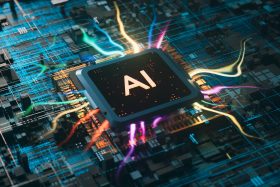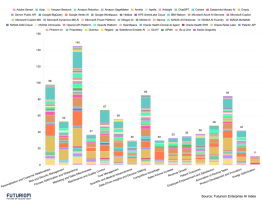NVIDIA Earnings Takeaways: Numbers Are Good, But Investors Hit Pause

A much-anticipated earnings release from NVIDIA was greeted with a bit of a yawn from the markets, as it had something for both bulls and bears.
After reporting revenue and earnings that slightly beat market expectations on Wednesday night, NVIDIA (NVDA) shares were slightly off on Thursday morning, trading down $1.21 to or .6%. to $180.3. NVIDIA shares recently hit an all-time high of $184.
Revenue and earnings numbers beat estimates, but there was a slight miss on datacenter revenue. The earnings call came with much anticipation, with investors growing more nervous about the AI hype cycle as well as uncertainty about international trade, especially with China. Let's run down the top takeaways.
Huang: ‘Trillions’ of Dollars in Opportunity
On the earnings call, management allayed fears about two looming issues: Blackwell demand and China sales. Management said that Blackwell is ramping on track and that China sales of the H20 chip could resume this year. But the company remained conservative on the China front, saying they have modeled no revenue coming from China in the current year. So now any China sales represent upside.
As usual, CEO Jensen Huang came out firing with his optimistic view of the technological future. He highlighted the Blackwell platform launch and emphasized NVIDIA's leadership in AI infrastructure amid a "new industrial revolution." In addition, Huang and CFO Colette Kress threw more fuel into the AI hype reactor by tossing out some large numbers, talking about “$3-4 trillion dollars” in AI infrastructure opportunity by 2030.
Huang said he sees enormous potential in enterprises building out AI infra for agentic AI, sales to China, and growth in new markets such as robotics.
At this point, NVIDIA needs to start talking about trillions of dollars to rationalize its share price. Its market capitalization is $4.4 trillion and at the current run rate it could hit annual sales of $200 billion-$250 billion in the next year, giving it a forward sales multiple of about 20X, which is quite high. In comparison, Apple currently trades at a sales multiple of 8X but has $400 billion in annual sales, with a market capitalization of $3.4 trillion.
Some of the risks mentioned in NVDIA’s earnings statement included potential supply-chain disruptions, increasing competition, regulatory challenges, and macroeconomic pressures affecting demand
Pros:
- NVIDIA's Q2 2025 EPS of $1.04 beat the forecast of $1.01; revenue of $46.7 billion topped $46.1 billion estimate.
- Datacenter revenue grew 56% YoY; gross margin at 72.4% (GAAP) and 72.7% (non-GAAP).
- Management set Q3 guidance at $54B with gross margins expected between 73.3-73.5%; they reaffirmed strong demand.
Cons:
- Datacenter revenue missed forecasts
- H20 chip shipments to China remain uncertain.
Blackwell and Rubin
The major negative was a slight miss in datacenter revenue, but the earnings print didn’t offer enough to knock most Wall St. sell-side analysts off of the bull train. The company offered enough evidence that two growth engines—Blackwell and China—remain on track.
NVIDIA's Blackwell revenue reached record levels, growing sequentially by 17%. Kress said shipments for the GB300 AI cluster system began in the second quarter.
“Demand signals remain rock solid with Hopper and Blackwell sold out across the board,” wrote Jefferies analyst Blayne Curtis in an investor note. “Blackwell Ultra ramp well underway alleviating concerns of supply chain issues going forward.”
One of the amazing things about NVIDIA is how it’s always got the next thing coming. Both Huang and Kress alluded to the next growth markets, including the next-generation chip platform, Rubin, as well as robotics.
Kress said Nvidia's successor to its popular Blackwell chip architecture, Rubin, is on track for volume production in 2026.
China and Robotics
One of the main issues investors were watching—China sales—was addressed in detail. Kress said that China shipments worth $2 billion to $5 billion could flow soon if restrictions ease, but the company has excluded that revenue from its third-quarter forecast. The company is prepared to pay the 15% in revenue-sharing to the U.S. government on licensed sales, though the rule has not been finalized.
Blackwell, China, and robotics remain key areas to watch because they represent the next potential growth markets. The build-out of AI infrastructure has powered NVIDIA's growth in the last several years. Next could be robotics, according to Huang. NVIDIA recently shipped Jetson AGX Thor, a robotics computing platform or "robot brain."
Robotics remains a small part of NVIDIA's business, but Huang and Kress said they're seeing signs of growth.
"Robotic applications require exponentially more compute on the device and in infrastructure, representing a significant long-term demand driver for our data center platform," said Kress.
Futuriom Take: As usual, NVIDIA delivered the earnings goods as well as a leading technology vision for the AI industry. But the slight datacenter miss and uncertainty about China will give investors pause, given the stock is hovering near all-time highs and has a huge growth premium.



















